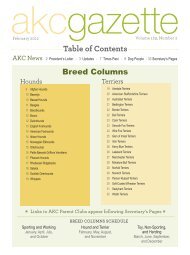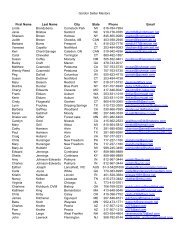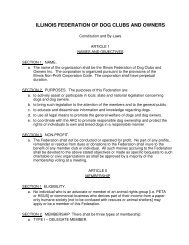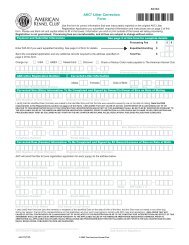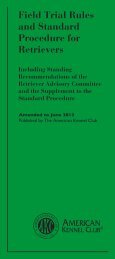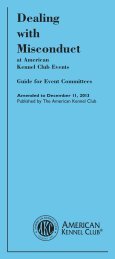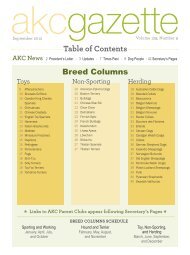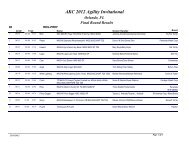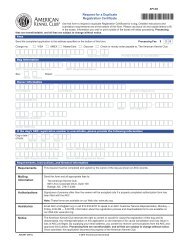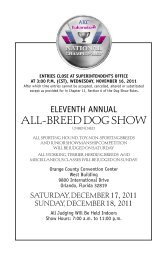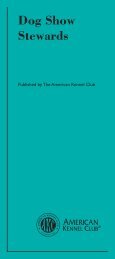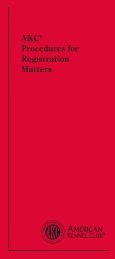You also want an ePaper? Increase the reach of your titles
YUMPU automatically turns print PDFs into web optimized ePapers that Google loves.
Section 5. Measuring the Course for Distance<br />
<strong>Judges</strong> must measure each course twice to determine the path of a 12" and 20"<br />
jumping dog respectively. These course measurements are used to determine<br />
the standard course times for the class. A judge shall use a measuring wheel to<br />
determine the distances a dog must travel to complete the course. All distances<br />
are measured on the ground and are based on the dog’s expected path. A<br />
judge shall measure around the outside of open tunnels and adjacent to contact<br />
obstacles and the weave poles.<br />
Things that affect the dog’s expected path:<br />
• 12" vs. 20" dog’s path (small dogs require less distance to make a turn).<br />
• In general, a judge should measure from the inside 1/3 of a jump to the<br />
inside 1/3 of the next jump for a 12" path, allowing less room for landing<br />
than the 20" path would.<br />
• In general, a judge should measure from the middle of a jump to the<br />
middle of the next jump for a 20" path, allowing room for landing<br />
and turning.<br />
• Surface and weather conditions should be accounted for when measuring.<br />
If it is slippery or raining, the judge may account for this in the path.<br />
• The speed a dog is expected to be traveling when asked to make a turn<br />
will affect the turning radius. For example, a dog with a straight 3-jump<br />
sequence into a 180-degree turn will turn much wider than a dog coming<br />
off a table going into the same 180-degree turn.<br />
Section 6. Standard Course Time (SCT) Tabulations<br />
After completing the measurement of the course, the judge shall compute the<br />
Standard Course Time (SCT) for each jump height and the Maximum Course<br />
Time (MCT) for the class. The judge converts the wheeled footage on the<br />
course to yards by dividing by 3 and rounding up to the nearest whole number<br />
if it is 0.5 or higher and rounding down if it is 0.4 or lower. This number is<br />
divided by the rate of speed assigned to each height and class level to determine<br />
the SCT (refer to the Regulations for rate of speed required in each height and<br />
class level). If the resulting value is not a whole number, it shall be rounded to<br />
the nearest whole number, with fractions of 0.5 and higher rounded up.<br />
The MCT for the class is determined by adding 20 seconds to the largest SCT.<br />
This whole number shall be used for all dogs in the class.<br />
SCTs in Excellent Standard and Excellent Jumpers with Weaves Classes:<br />
There are maximum allowable course times (course time limits) assigned in<br />
the Regulations for all Excellent classes. These course time limits may not<br />
43




